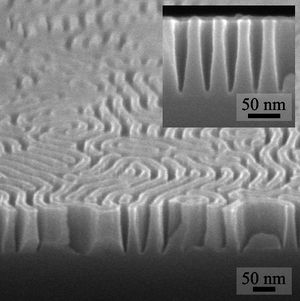Difference between revisions of "Realspace"
KevinYager (talk | contribs) |
KevinYager (talk | contribs) |
||
| Line 1: | Line 1: | ||
[[Image:BCP etch.jpg|thumb|300px|Example realspace image (SEM) of a [[block-copolymer]] pattern etched into silicon.]] | [[Image:BCP etch.jpg|thumb|300px|Example realspace image (SEM) of a [[block-copolymer]] pattern etched into silicon.]] | ||
| − | '''Realspace''' or '''direct-space''' is simply the regular 3D space that we inhabit. In scattering, it is introduced as a term to differentiate from [[reciprocal-space]] (a.k.a. inverse-space). Whereas reciprocal-space refers to the [[Fourier transform]] of the sample's structure, realspace refers to the actual structure: the electron-density spatial distribution (as imaged in SEM, TEM, AFM, STM, etc.). | + | '''Realspace''' or '''direct-space''' is simply the regular 3D space that we inhabit. In scattering, it is introduced as a term to differentiate from [[reciprocal-space]] (a.k.a. inverse-space). Whereas reciprocal-space refers to the [[Fourier transform]] of the sample's structure, realspace refers to the actual structure: the [[electron-density distribution|electron-density spatial distribution]] (as imaged in SEM, TEM, AFM, STM, etc.). |
Revision as of 13:53, 16 December 2014

Example realspace image (SEM) of a block-copolymer pattern etched into silicon.
Realspace or direct-space is simply the regular 3D space that we inhabit. In scattering, it is introduced as a term to differentiate from reciprocal-space (a.k.a. inverse-space). Whereas reciprocal-space refers to the Fourier transform of the sample's structure, realspace refers to the actual structure: the electron-density spatial distribution (as imaged in SEM, TEM, AFM, STM, etc.).